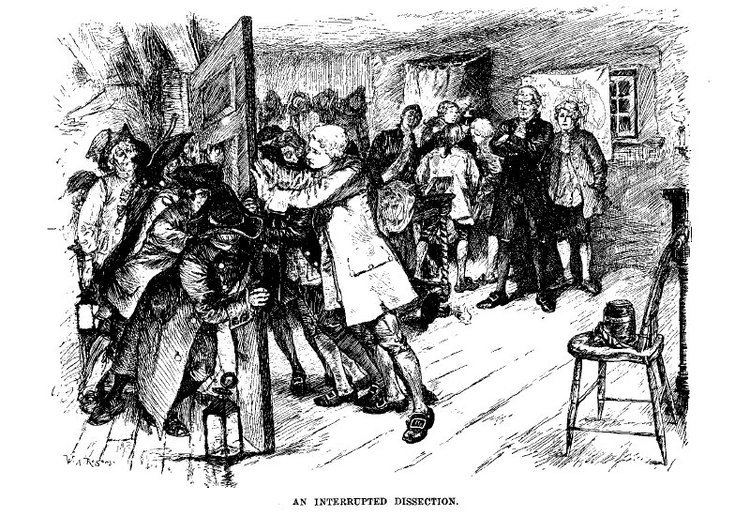 | ||
The Doctors' riot was an incident that occurred in April 1788 in New York City, where the illegal procurement of corpses from the graves of slaves and poor whites, resulted in a mass expression of discontent from poorer New Yorkers directed primarily at physicians and medical students.
Contents
Background
By the end of the American Revolution, roughly one fifth of New York City's population was black, most of whom were slaves. The construction of New York City, under both the Dutch and the English, was accomplished largely with slave labor. Due to their low social standing, the bodies of slaves could only be buried outside the city limits. Most often they were interred in a small number of plots north of Chambers Street, across the street from the Pauper's Cemetery, often with several bodies to a grave, in a site now marked by the African Burial Ground National Monument, then known as the "Negroes Burying Ground".
Both cemeteries were located close to Columbia College, which housed the city's only school of medicine. Due to taboos associated with the violation of corpses, procuring cadavers for study was difficult, and many students and doctors would exhume bodies from the nearby graveyards due to the socially marginalized status of their occupants. “Resurrection”, as body-snatching or grave-robbing was called, was the cheapest, surest way to obtain the remains of the newly deceased, especially in the winter when bodies decayed at a slower rate.
The riot
Because there was, at the time, no known method of preserving an entire corpse, thefts were performed hastily, often in winter to slow the rate of decomposition. In the winter of 1788, the number of corpses being exhumed by students increased substantially. The activities of medical students and physicians, who were known colloquially as Resurrectionists in the Black cemetery, were noticed by a group of freedmen who, on February the 3rd, petitioned the Common Council to take action against it. The petition was largely ignored, and no effort was made to stop the unlicensed exhumations.
In April 1788, a group of children were playing outside the New York Hospital, next to a room where a student of the physician Richard Bayley, who was known to exhume corpses from the two cemeteries, was dissecting an arm. Bayley, born and bred in Connecticut, had received his medical education in England, where body-snatching was more common. There were whispers about him “cutting up his patients and performing cruel experiments upon the sick”. The student, named John Hicks, waved the arm out at the children, telling a boy whose mother had recently died that it belonged to her. The boy ran home and told his father of this, who, after exhuming his wife's coffin and finding it empty, amassed a group of concerned citizens who marched to the hospital and began to mass around the building. The mob eventually broke into the hospital and, after becoming incensed upon finding several bodies in various stages of mutilation, pulled Richard Bayley's assistant Wright Post and a number of his students into the street, where the mayor of New York City, James Duane intervened and ordered them escorted to the jailhouse for protection.
A crowd of 2,000 people had gathered, and news spread of the horrors seen in the hospital, leading to widespread rioting, with the few physicians remaining in New York City being forced into hiding. A large group of rioters descended upon Broadway, searching for John Hicks, who was felt by the crowd to be the main source of blame. As they assembled in front of the courthouse, throwing rocks, militia and cavalry were called in to repel them. The riot lasted a few days, ceasing when Governor Clinton sent the militia to patrol the streets until a calm environment was ensured.
At least three rioters and three militiamen died in the confrontation; some estimate up to 20 dead. The protesters also destroyed all the available human specimens.
Effects
Public opinion of the physicians in New York stood very low for many years, and while some students were brought to trial, Hicks was not among them. Post-mortem dissection was considered an indignity to the dead and the city fathers even forbade using bodies abandoned in the rougher parts of the city. A year later, in January 1789, a statute was finally put into law in order to codify the proper treatment of corpses, with harsh punishments imposed for those who violated it. Anyone who broke the law would stand on the pillory or be publicly whipped, fined, or imprisoned. The statute also permitted the bodies of executed criminals to be used in dissection, “in order that science [might not] be injured by preventing the dissection of proper subjects”. “Resurrection men”, professionals who used stealth and discretion, were recruited to replace the students and went on to control the supply of cadavers for generations. Throughout the 1700s, British law considered dissection as a worse punishment than death. To discourage dueling, the Massachusetts General Court also imposed dissection as a threat by ruling that anyone who died as a result of a duel would be sentenced to post-mortem dissection and dismemberment. Dissection was seen as perhaps one of the worst things that could happen to a person after their death.
